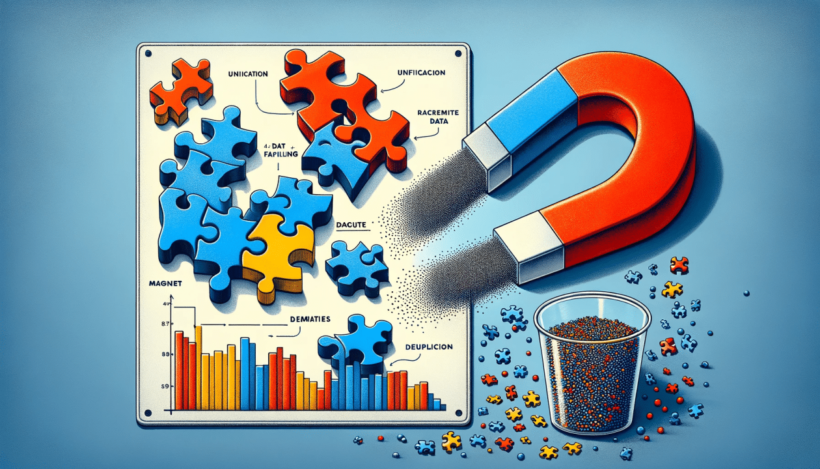Why Data Decay Isn’t Just a Problem … It’s an Opportunity to Grow
Published by Bryce Jones on January 26, 2023
How fast does your data decay? Maybe 20%, 30%, or more per year? If you’re a B2B company and you guessed somewhere around 70% per year, you’d be correct, according to a report published by Gartner. And that decay can lead to all kinds of problems — everything from duplicate reach outs to leads and opportunities growing cold and more. As a result, the cost of bad data is high.
George Labovitz and Yu Sang Chang developed the 1-10-100 rule, also known as “the cost of quality.” Using this rule, you could say that if the cost of preventing bad data or data decay is $1, the cost of fixing it is $10, and the cost of doing nothing is $100.
You can use various solutions to fix the problem, but a new solution powered by AI goes a step further: It helps you spot new opportunities and potentially save deals.
Consider this scenario:
A sales representative works hard on a deal for several months, and the deal is just steps away from closing. Then, suddenly, emails go unanswered or even bounced, calls go unreturned, and the lead goes cold.
What happened?
Let’s consider an alternative scenario that provides the answer. You receive a real-time alert that your primary contact has left the company, and the deal is at risk. Now, you can be proactive. You can contact the company, find out who replaced your prior contact, and start following up immediately — before the lead goes cold.
And interestingly enough…
Imagine that the lead who left the company has moved to a different organization — one you’ve been attempting to meet with for months. Now you have a relationship with a key decision-maker at the new company, and you’re positioned to secure that meeting.
But how does this type of technology work?
How AI-Powered Technology Helps You Tap into New Opportunities
Your company likely has a large amount of data housed in your CRM. But that data isn’t useful unless it’s of high quality. A technology that leverages AI can check your CRM data against external sources to ensure information is up to date and flag new opportunities. For example, a system can detect when a person is promoted, has changed employers, or has experienced any other relevant changes, and can push real-time alerts to your salesperson.
![]()
A few potential opportunities:
The system notifies sales teams of at-risk opportunities. If you use Salesforce, each company has an account, and you can see various contacts and their roles. If a person leaves the company, the system automatically flags the account as “at risk” so your salesperson can take action quickly and work to save a deal.
Spot new opportunities for deals via contact job tracking. If you’ve worked with a person in the past and they switch jobs, you want to keep track of them. Their new employer may also be in your target market, which could create an entirely new opportunity. Plus, since that person knows and likes your product or services, you automatically have an advocate in a new company. Tracking jobs can provide sales with relational intelligence to bring in new internal sponsors to your deal conversations.
Discover answers to previously unanswered questions. As we mentioned earlier, sometimes a lead will go cold without explanation. They stopped responding to emails and answering phone calls when everything had seemed fine. Often the answer to their silence is a job change. Recent research found that roughly one in five workers are “very” or “somewhat likely” to look for a new job in the next six months.
Additionally, the “Great Resignation” created historic job changes, with 47.8 million people quitting their jobs in 2021 alone. In 2022, there was also 30% of the workforce or about 50 million that changed jobs.
With an AI-powered tool, you get a real-time alert if a contact leaves, helping you stay ahead of job changes and keep data current. And this is a critical capability in the context of customer retention since it’s seven times less expensive to retain an existing client than to acquire a new one. Additionally, increasing customer retention rates by as little as 5% can increase profits by 25%-95%.
Rethinking Data Decay and Growth Opportunities
Data decay isn’t a problem that will completely go away. People will continue to change jobs and data will continue to evolve, so it’s more about your approach to proactively handling outdated data and how quickly you can update it. And, of course, it’s also about leveraging that data to create more opportunities and drive revenue.
And that’s how an AI-powered tool can help. It supports you by keeping your data current while spotting new opportunities that might have otherwise gone unnoticed. As a result, your salespeople will have more actionable information, which will result in fewer lost deals, fewer productivity losses, and higher revenue.
Want to track job changes in Salesforce?







